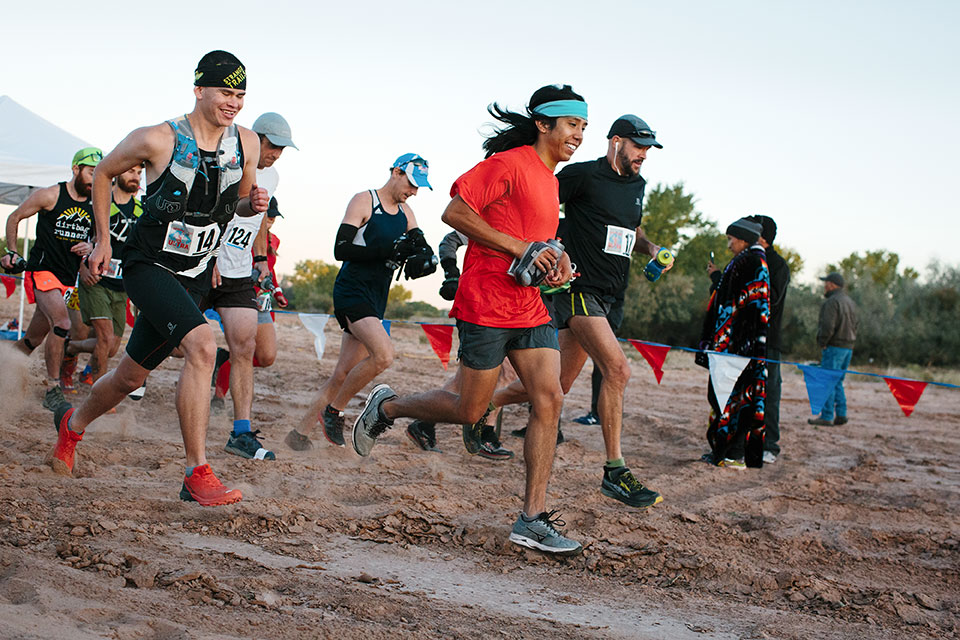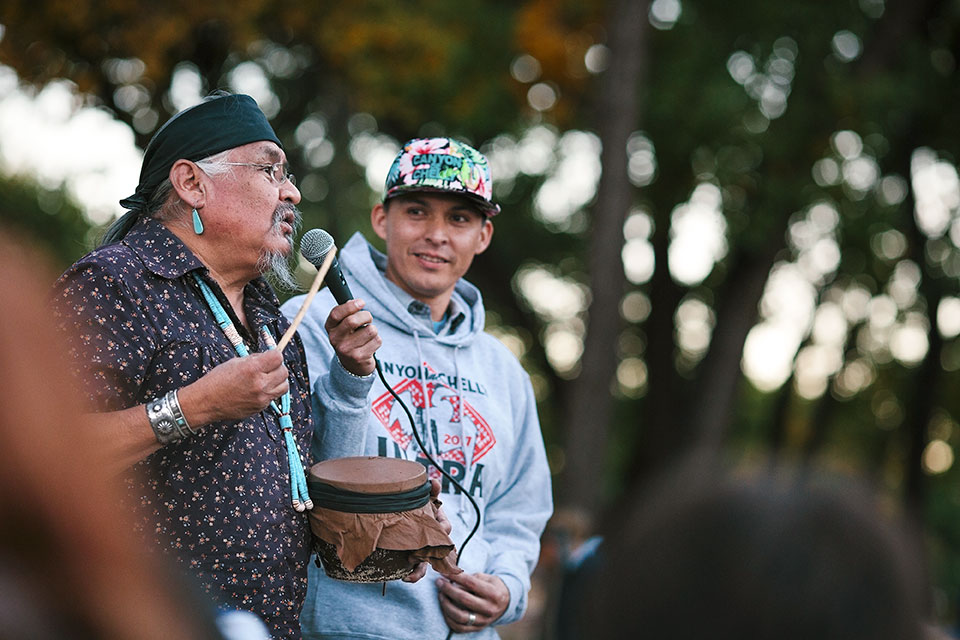It’s early morning up on the Navajo Nation, the sun beginning to rise, the red-rock cliffs slanted in shadow. And Shaun Martin is there to greet the day.
Martin runs each morning in tribute to the sunrise. He’s been doing this since childhood, when he’d wake early with his father and they’d greet the dawn together, in that vast landscape of sand and sculptured rock. It’s part of his tradition as a Navajo.
Today, Martin isn’t alone. He’s the race director for the Canyon de Chelly Ultra (short for “ultramarathon,” any footrace longer than a standard 26.2-mile marathon), and before the race’s start, 150 runners gather around a ceremonial fire, wearing brightly colored shirts, fancy hydration packs strapped across their backs. Navajo elders Allen Martin and William Yazzie perform a traditional blessing, using an eagle feather and cedar smoke and reciting a prayer in both Diné and English. And then the runners are off, yelling and cheering as they set out on their trek.
The 55-kilometer (about 34-mile) race leads runners past sandstone, Native petroglyphs and pictographs, ancient cliff dwellings and an up-close view of Spider Rock — a 700-foot sandstone formation honoring Spider Woman, who is regarded as sacred to the Navajos.
The race blends the logistics of ultras with Navajo philosophies and also throws in a few challenges: miles and miles of calf-crushing sand, water crossings and a lung-busting 1,200-foot climb.
“You’re going back in time and into another place,” says Garth Reader, of New Mexico. “The walls keep getting bigger and bigger as you run into the canyon, and Spider Woman rock starts rising up until it’s towering above you, and everything echoes off the walls.”
There’s also a chance of glimpsing the wild horses roaming the area. Laura Swenson experienced one such sighting during the 2015 race. “There was a white mare with her foal nursing,” she says. “The foal paused to look up as I ran by. It was an unforgettable sight.”
Canyon de Chelly is a sacred Navajo site of staggering beauty. The national monument, managed by the Navajo Nation and the National Park Service, includes 84,000 acres, and around 40 families still live there. With the exception of the White House Ruins Trail, non-Natives are prohibited from exploring the canyon unless accompanied by a Navajo guide or park ranger.
Those restrictions are lifted, however, during the race, when bib-wearing runners can travel through the canyon solo and at their own pace. The first year, the race sold out in a day and a half. The second year, in six hours. By the third year, it was down to three minutes. The fourth, less than a minute. And last year, the fifth, a registration frenzy crashed the site when more than 1,000 people attempted to sign up the moment registration opened.
“We were on the computer; there were four of us trying to get in,” says former racer Mark Bean, who, because of cartilage problems in his knee, was desperate to enter last year’s race, likely his last ultra. “I’m not a religious guy, but I’m sort of spiritual, and I thought, We were meant to do this. And lo and behold, we got in.”
Proceeds from the race are funneled back into the community, supporting Navajo runners through shoe and uniform purchases, race entries, travel expenses and other necessities.
Martin, the race director, has the lean-bodied grace of a long-distance runner. He grew up in LeChee, near Page, and his sunrise runs with his father led to state titles in cross-country and track, along with a full scholarship to Northern Arizona University, where he met his wife — they now have two children. After graduation, the couple returned to tribal land and Martin taught and coached at Chinle High School for nine years. He now works as a school administrator.
The Canyon de Chelly race idea hit Martin during a training run through the canyon, in a light “female rain” (in Diné, a gentle rain is female, an aggressive rain male), after he spooked a group of horses. The horses took off, and Martin ran behind until the herd slowed to keep pace with a young colt.
“I ran, stride for stride and shoulder to shoulder, with this colt inside this herd of wild horses,” Martin says. “It was like they had accepted me.”
At the mouth of the canyon, the horses stopped.

“I looked at them, and they were looking at me, and I just took in this experience,” Martin says. I forgot about time and fatigue, and everything else in the world, [and felt] 100 percent connection to the Earth and the canyon.”
The experience moved him so much that he decided to share it. On Facebook, he posted the idea of a race, asking if anyone would be interested. The response was overwhelming, and the Canyon de Chelly Ultra was born.
“My No. 1 goal for [the racers] is not to understand Navajo culture, but to make a connection to whatever it is they’re looking for,” he says. “We’re all looking for something in this physical world.”
Race finishers are awarded a hand-beaded necklace crafted by Martin, his wife and his grandmother. Martin places one around the neck of each runner who crosses the finish line. Winning runners are awarded hand-beaded bracelets, Navajo rugs and pottery, and the youngest and oldest finishers, plus the one who traveled the farthest for the race, are also celebrated.
“When I’m making that bracelet, I’m singing prayer songs and putting all of these good thoughts and good songs into that piece of art,” Martin says. “Whoever gets the necklace or bracelet gets the good thoughts and good prayers for life.”
Kaye Christensen Beeny is a busy mother and wife from Salt Lake City who has run the race twice. Her last race didn’t go as planned. She got sick while struggling up the steep canyon incline. Then she saw a tarantula and remembered the pre-race story Yazzie, the Navajo elder, told about Spider Woman, who was regarded as a warrior.
“I felt like it was a sign, from spirits long gone, that everything was going to be OK — not just the race, but that everything was fine, and that I just had to let go and muddle through,” she says.
The realization gave her the courage to yell while running through the canyon. This wasn’t easy. She’d been raised to be seen and not heard.
“I didn’t feel I could lift my voice up and say thank you to the sun and spirits of the canyon,” she says. “I didn’t feel as if I was entitled to feel that way.”
After she saw the spider, that changed.
“I thought, I can do this. I’ve earned this.”
And she yelled.
“It was very raw and very vulnerable,” she says. “It was a real turning point, not just in the race, but in the way I approached my job and my family.”
It didn’t magically solve everything, she says, and she still has things she needs to work through.
“But I thought, I’ve earned this. I’m entitled to this. I’m entitled to my feelings, and to expressing them.”
Bean, the runner with the knee injury, is a Chicago police officer. At Canyon de Chelly, he, too, had an epiphany — one that had to do with his late father, who ran the Boston Marathon and first introduced Bean to the sport.
“On the way back was when the emotional stuff started happening,” he says. “You’re at the point when you’re getting tired, and that’s when it all comes out.”
He’d heard that if you grab a handful of leaves while in the canyon, think good thoughts and release them, the feelings will remain there.
“And I thought, I have to do this. I have to give something back. I can’t just come here and experience this without leaving something.”

Bean had recently lost an aunt and a beloved dog. He decided to thank them, along with his father. And that’s what he did in the middle of the race, perhaps the last ultra he’ll ever run. He thanked the spirits and his loved ones, and then he opened his hand and let the leaves go.
“I just started crying,” he says. “And I loved it. I wasn’t ashamed. It was one of the most cherished and beautiful moments of my life.”
He finished the race, struggling through the last miles of deep sand, and Martin placed his finisher’s necklace around his neck.
Bean’s uncle, who had encouraged him to enter the race, received the award for oldest finisher, at age 74.
Bean believes he was meant to run the race and says he’ll never forget how he felt while running in the canyon.
“It’s very energizing, very moving,” he says. “My soul was connected. My spirit was connected. I’ve never felt anything like that before.”
Night is preparing to fall across the canyon when the last runner crosses the finish line. He’s blessed with water, and the ceremonial fire, kept alive for the duration of the race, is put to sleep. Now it’s time for runners to gather with new friends and family; eat traditional Navajo foods such as blue corn mush, fry bread and mutton stew; and celebrate not only the race, but also everything the canyon has shown and given them.
“I will enter every year for the rest of my life,” Beeny says. “You feel so connected with everyone. It’s a beautiful place, and the people are beautiful, too.”

